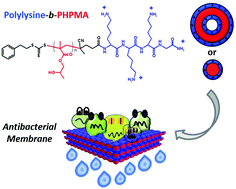Antimicrobial polylysine decorated nano-structures prepared through polymerization induced self-assembly (PISA)†
Abstract
A large variety of nanoparticles have already been prepared via the PISA methodology from methacrylic block copolymers. Here we report the very first example of polypeptide decorated nanoparticles prepared using RAFT aqueous dispersion polymerization. This work explores the original combination of PISA with functional polypeptides. A short polypeptide consisting of 3 lysines, modified with a RAFT chain transfer agent moiety, was used to conduct RAFT dispersion polymerization of 2-hydroxypropyl methacrylate (HPMA) in water at 60 °C. The positively charged water-soluble polylysine acted as the steric stabilizer for the colloidal particles generated by self-assembly of the growing amphiphilic block copolymer, resulting in the in situ formation of different polypeptide-polymer nano-objects depending on the degree of polymerization of the core-forming polymer block (PHPMA). These colloidally stable nanoparticles exhibit antibacterial properties against both Gram negative (Escherichia coli) and Gram positive (Staphylococcus epidermidis) bacteria due to the presence of the positively charged polylysine chains on their surface. Thin film membranes were prepared by spin-coating of a colloidal solution of polypeptide-decorated spherical nanoparticles. This porous thin film was then used for filtration of water containing S. epidermidis bacteria. Both the polypeptide-decorated nanoparticle solution and thin film membrane possessed significant antibacterial activity.



 Please wait while we load your content...
Please wait while we load your content...